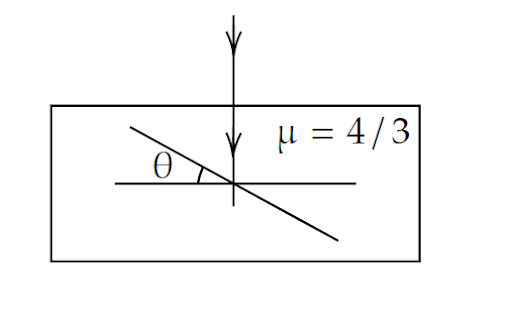
A plane mirror is placed horizontally inside water\[\left( {\mu = \dfrac{4}{3}} \right)\]. A ray falls normally on it. Then, the mirror is rotated at an angle \[\theta \]. What is the minimum value of \[\theta \] for which the ray does not come out of the water surface?

A. \[\dfrac{\pi }{4}\]
B. \[{\sin ^{ - 1}}\left( {\dfrac{3}{4}} \right)\]
C. \[\dfrac{1}{2}{\sin ^{ - 1}}\left( {\dfrac{3}{4}} \right)\]
D. \[2{\sin ^{ - 1}}\left( {\dfrac{3}{4}} \right)\]
Answer
218.7k+ views
Hint:Before solving the problem, let us understand the total internal reflection and critical angle. As there are two different mediums of different materials, a light wave is entering from one medium to another. If the light wave at the intersection of these mediums, instead of being refracted, gets reflected back into the first medium we say it as total internal reflection. When the angle of incidence of this light ray leads to a refraction of light whose angle is, we call it \[{90^0}\] as critical angle.
Formula Used:
The condition for the total internal reflection is given by t,
\[\sin \left( i \right) > \sin {\theta _C}\]…………… (1)
Where, \[i\] is the angle of incidence, \[{\theta _C}\] is the critical angle and \[R\] is the radius of the flat track.
Complete step by step solution:
If the mirror is rotated at an angle of \[\theta \], then the reflected ray rotates at an angle of \[2\theta \]
So, from equation (1) we have,
\[\sin \left( i \right) > \sin {\theta _C}\]
\[\Rightarrow \sin \left( r \right) > \sin {\theta _C}\]
\[\Rightarrow \sin \left( {2\theta } \right) > \sin {\theta _C}\]
But we know the formula to find the critical angle is,
\[\sin {\theta _C} = \left( {\dfrac{1}{\mu }} \right)\]
Substituting the value of the critical angle in the above equation, we get,
\[\sin \left( {2\theta } \right) > \left( {\dfrac{1}{\mu }} \right)\]
\[\Rightarrow 2\theta > {\sin ^{ - 1}}\left( {\dfrac{1}{\mu }} \right)\]
\[\Rightarrow \theta > \dfrac{1}{2}{\sin ^{ - 1}}\left( {\dfrac{1}{\mu }} \right)\]
By data we have \[\left( {\mu = \dfrac{4}{3}} \right)\].
Substituting this value in the above equation we get,
\[\theta > \dfrac{1}{2}{\sin ^{ - 1}}\left( {\dfrac{1}{{\left( {\dfrac{4}{3}} \right)}}} \right)\]
\[ \therefore \theta > \dfrac{1}{2}{\sin ^{ - 1}}\left( {\dfrac{3}{4}} \right)\]
Therefore, the minimum value of \[\theta \]for which the ray does not come out of the water surface is \[\dfrac{1}{2}{\sin ^{ - 1}}\left( {\dfrac{3}{4}} \right)\].
Hence, Option C is the correct answer
Note: Always remember that the conditions for the total internal reflection are;
1. Light must travel from a denser medium into a less dense medium (i.e., from glass to air).
2. The angle of incidence should be greater than the critical angle.
Formula Used:
The condition for the total internal reflection is given by t,
\[\sin \left( i \right) > \sin {\theta _C}\]…………… (1)
Where, \[i\] is the angle of incidence, \[{\theta _C}\] is the critical angle and \[R\] is the radius of the flat track.
Complete step by step solution:
If the mirror is rotated at an angle of \[\theta \], then the reflected ray rotates at an angle of \[2\theta \]
So, from equation (1) we have,
\[\sin \left( i \right) > \sin {\theta _C}\]
\[\Rightarrow \sin \left( r \right) > \sin {\theta _C}\]
\[\Rightarrow \sin \left( {2\theta } \right) > \sin {\theta _C}\]
But we know the formula to find the critical angle is,
\[\sin {\theta _C} = \left( {\dfrac{1}{\mu }} \right)\]
Substituting the value of the critical angle in the above equation, we get,
\[\sin \left( {2\theta } \right) > \left( {\dfrac{1}{\mu }} \right)\]
\[\Rightarrow 2\theta > {\sin ^{ - 1}}\left( {\dfrac{1}{\mu }} \right)\]
\[\Rightarrow \theta > \dfrac{1}{2}{\sin ^{ - 1}}\left( {\dfrac{1}{\mu }} \right)\]
By data we have \[\left( {\mu = \dfrac{4}{3}} \right)\].
Substituting this value in the above equation we get,
\[\theta > \dfrac{1}{2}{\sin ^{ - 1}}\left( {\dfrac{1}{{\left( {\dfrac{4}{3}} \right)}}} \right)\]
\[ \therefore \theta > \dfrac{1}{2}{\sin ^{ - 1}}\left( {\dfrac{3}{4}} \right)\]
Therefore, the minimum value of \[\theta \]for which the ray does not come out of the water surface is \[\dfrac{1}{2}{\sin ^{ - 1}}\left( {\dfrac{3}{4}} \right)\].
Hence, Option C is the correct answer
Note: Always remember that the conditions for the total internal reflection are;
1. Light must travel from a denser medium into a less dense medium (i.e., from glass to air).
2. The angle of incidence should be greater than the critical angle.
Recently Updated Pages
A square frame of side 10 cm and a long straight wire class 12 physics JEE_Main

The work done in slowly moving an electron of charge class 12 physics JEE_Main

Two identical charged spheres suspended from a common class 12 physics JEE_Main

According to Bohrs theory the timeaveraged magnetic class 12 physics JEE_Main

ill in the blanks Pure tungsten has A Low resistivity class 12 physics JEE_Main

The value of the resistor RS needed in the DC voltage class 12 physics JEE_Main

Trending doubts
JEE Main 2026: Application Form Open, Exam Dates, Syllabus, Eligibility & Question Papers

Derivation of Equation of Trajectory Explained for Students

Hybridisation in Chemistry – Concept, Types & Applications

Understanding the Angle of Deviation in a Prism

Understanding Collisions: Types and Examples for Students

Understanding Atomic Structure for Beginners

Other Pages
JEE Advanced Marks vs Ranks 2025: Understanding Category-wise Qualifying Marks and Previous Year Cut-offs

How to Convert a Galvanometer into an Ammeter or Voltmeter

Understanding Centrifugal Force in Physics

JEE Main Marking Scheme 2026- Paper-Wise Marks Distribution and Negative Marking Details

Degree of Dissociation: Meaning, Formula, Calculation & Uses

Understanding Electromagnetic Waves and Their Importance




